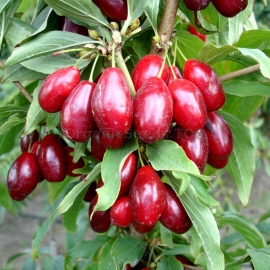




Organic Cornelian Cherry Seeds (Cоrnus mas)
1.14 €
The Cornelian Cherry or Cherry Dogwood is an early blooming small dogwood bearing tiny yellow flowers. A year-round ornamental with nice fall colors and edible 3/4-inch bright scarlet berries.
-
Organic Cornelian Cherry (Cornus Mas)
The Cornelian Cherry or Cherry Dogwood is an early blooming small dogwood bearing tiny yellow flowers. A year-round ornamental with nice fall colors and edible 3/4-inch bright scarlet berries.
Since it blooms before most other trees or plants it is a welcomed sight in a bare garden. Rounded and multitrunked with gray and tan bark. When planted with an evergreen background or where it will be backlit from the sun this tree is even more beautiful.
How to Grow
Seeds of the Cornelian Cherry have a deep dormancy within them, this requires a degree of patience to overcome and it is usually quite easy to get high levels of germination if the correct procedures are followed.
First prepare a free draining substrate into which the seeds are to be mixed, this can be a 50/50 mixture of compost and sharp sand, or perlite, vermiculite. The chosen substrate needs to be moist (but not wet), if you can squeeze water out of it with your hand it is too wet and your seeds may drown and die. Mix the seeds into the substrate, making sure that their is enough volume of material to keep the seeds separated. Place the seed mixture into a clear plastic bag (freezer bags, especially zip-lock bags are very useful for this -provided a little gap is left in the seal for air exchange) If it is not a zip-lock type bag it needs to be loosely tied. Then write the date on the bag so that you know when the pretreatment was started.
The seeds first require a period of warm pretreatment and need to be kept in temperatures of 20 Celsius (68F) for a period of around 12 weeks . During this time make sure that the pretreatment medium does not dry out at any stage or it will be ineffective!
Following this the seeds require a cold period to break the final part of the dormancy, this is easily achieved by placing the bag in the fridge at (4 Celsius or 39F) for at least 12 weeks (possibly up to 29 weeks). When the dormancy has been broken it is quite possible for the seeds to germinate in the bag at these temperatures, if they do, just remove them from the bag and carefully plant them up. When the period of pre-treatment has finished the seed should be ready to be planted. Small quantities can be sown in pots or seed trays filled with a good quality compost and cover them with a thin layer of compost no more than 1 cm deep. For larger quantities it is easiest to sow the seeds in a well prepared seedbed outdoors once the warm and cold pre-treatments have finished and wait for the seedlings to appear.
It has also been found that fluctuating pretreatment temperatures can give the best germination results and I have myself had excellent results by keeping the mixed seeds in a cold shed through the winter for the cold stage of their pretreatment and allowing the temperature to fluctuate naturally. Ungerminated seeds can have the whole warm and cold process repeated again to enable more seeds to germinate. Fresh seedlings can keep germinating for several years after the original sowing date.
Do not expose newly sown seeds to high temperatures (above 25 Celsius). Keep the seedlings well watered and weed free. Growth in the first year is usually between 10 and 50cm depending on the time of germination and cultural techniques and developing seedlings are usually trouble free. Allow them to grow for 1 or 2 years before planting them in a permanent position.
